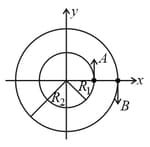D. C. Pandey Solutions for Chapter: Circular Motion, Exercise 1: Excercise 1
D. C. Pandey Physics Solutions for Exercise - D. C. Pandey Solutions for Chapter: Circular Motion, Exercise 1: Excercise 1
Attempt the free practice questions on Chapter 7: Circular Motion, Exercise 1: Excercise 1 with hints and solutions to strengthen your understanding. Complete Study Pack for Engineering Entrances Objective Physics Vol 1 solutions are prepared by Experienced Embibe Experts.
Questions from D. C. Pandey Solutions for Chapter: Circular Motion, Exercise 1: Excercise 1 with Hints & Solutions
A particle moves such that its position vector where is a constant and is time. Then, which of the following statements is true for the velocity and acceleration of the particle?
A particle is moving along a circular path with a constant speed of . What is the magnitude of the change in velocity of the particle, when it moves through an angle of around the centre of the circle?
Two particles and are moving on two concentric circles of radii and with equal angular speed . At their positions and direction of motion are shown in the figure. The relative velocity at is given by,

If the radius of the circular path and frequency of revolution of a particle of mass are doubled, then the change in its kinetic energy will be ( and are the initial and final kinetic energies of the particle, respectively),
A body of mass is performing a UCM in a circle of radius with speed . The work done by the centripetal force in moving it through of the circular path is,
A ball uniformly moves one-fourth of a circle of radius in time . Let and be the magnitudes of mean speed and mean velocity vector. The ratio will be,
